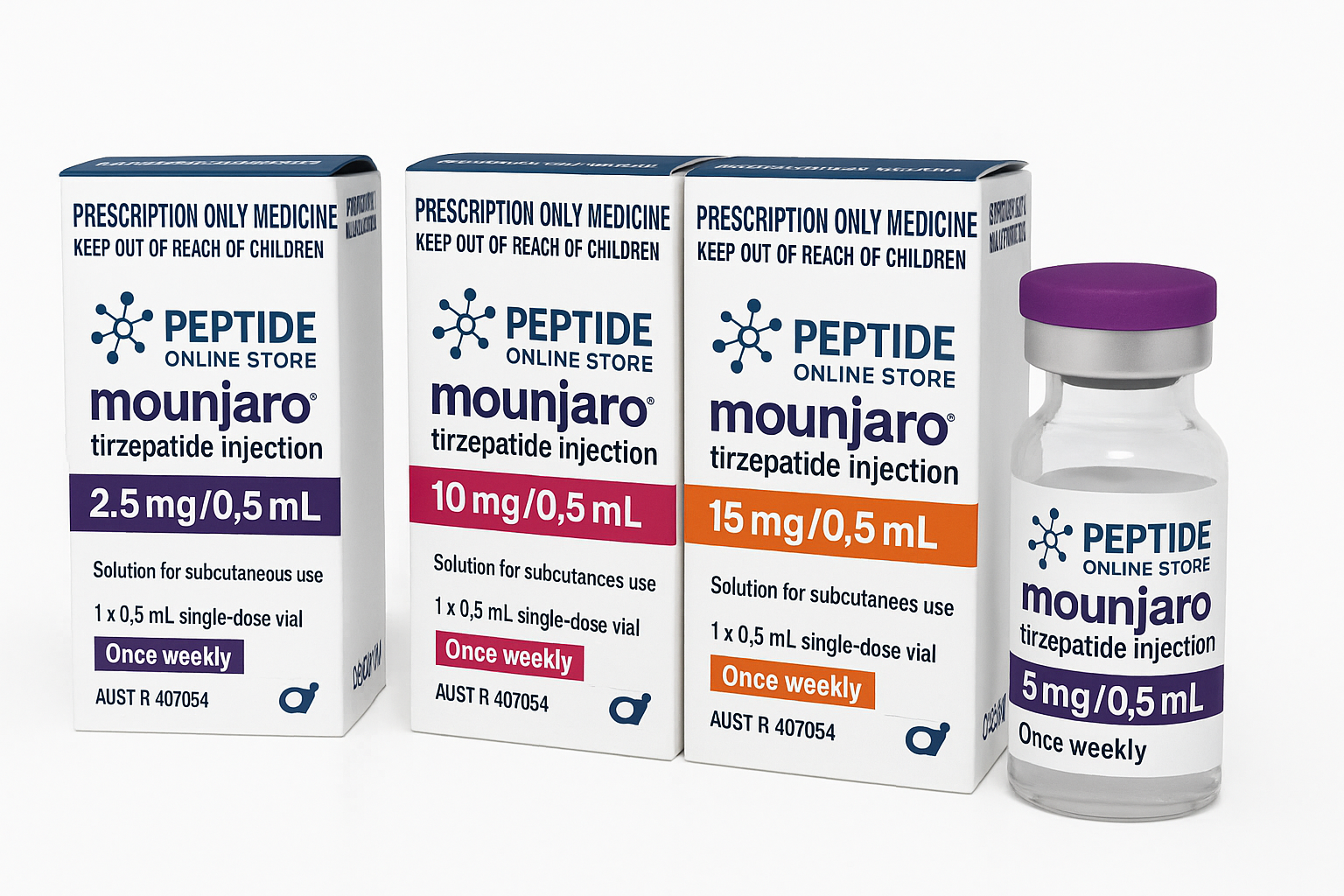Mounjaro 10 mg 0.5 mL Solution is a once-weekly injectable medication containing tirzepatide, a dual GIP and GLP-1 receptor agonist. Designed for adults with type 2 diabetes, it helps regulate blood sugar and supports weight loss as a secondary benefit. Delivered subcutaneously via a pre-filled pen or vial, this 10 mg dose is part of the recommended maintenance range after initial dose escalation. Mounjaro offers a powerful, convenient treatment option for improving glycemic control with added metabolic advantages.
Mounjaro 10 mg 0.5mL Solution
$164.99 – $989.94Price range: $164.99 through $989.94
SKU: N/A
Category: Peptide
Tags: .5 ml mounjaro, Mounjaro - 10mg/0.5mL Solution, Mounjaro 10 mg, mounjaro 10 mg shortage update, mounjaro 10 mg0 5 ml pen, mounjaro 10mg in stock near me, mounjaro 10mg pen, mounjaro 10mg shortage, mounjaro 5 mg price, mounjaro 5mg box, mounjaro 5mg/0.5ml, mounjaro 7.5 mg / 0.5 ml pre filled pen 4 s, mounjaro 7.5mg sol for inj (0.5ml x 4 prefilled pen), mounjaro click chart, mounjaro dosage chart, mounjaro dose for weight loss, mounjaro medication
Mounjaro 10 mg 0.5 mL is a weekly injectable treatment with dual GIP and GLP‑1 agonist action, specifically approved for type 2 diabetes management in adults. It’s designed to simplify dosing and improve glycemic control, with potential benefits in weight management when combined with lifestyle changes. Proper patient selection, awareness of contraindications, and adherence to storage and dosing guidelines are essential for safe and effective use.
- Mounjaro is a prescription medication in all states.
- Mounjaro comes in vials or Pens (Kwikpens)
- Kwikpen: A kwikpen contains 4 doses and comes with 4 needles.
- Vial: A vial contains a single dose and comes with one needle. Most patients need 4 vials (doses) per month.
- Customers in DE, TN, FL, or the Virgin Islands need a prescription for the syringe as well and need to include it with their Mounjaro prescription.
Mounjaro (Tirzepatide)
Mounjaro (Tirzepatide) is an injectable prescription medication used alongside diet and exercise to improve blood sugar levels in adults with type 2 diabetes mellitus.
Why Choose Mounjaro (Tirzepatide)?
Mounjaro (Tirzepatide) is a treatment option for adults with type 2 diabetes when diet and exercise alone do not control blood sugar levels adequately. It is the first and only GIP and GLP-1 receptor agonist medication that activates natural incretin hormones to regulate blood sugar levels. In clinical trials, it has been shown to deliver superior A1C reductions, and for eligible patients, it can also support weight loss efforts.
How to Use Mounjaro (Tirzepatide)?
Mounjaro is an injectable medication prescribed for adults with type 2 diabetes to help manage their blood sugar levels. To ensure safe and effective use, patients should:
- Read the Medication Guide and Instructions For Use provided by their pharmacist before starting and each time they get a refill.
- Administer Mounjaro as a subcutaneous injection once a week, using the single-dose pen which comes in various dosages: 2.5 mg, 5 mg, 7.5 mg, 10 mg, 12.5 mg, and 15 mg per 0.5 mL.
- Start with a 2.5 mg dose once a week for the first four weeks, then potentially increase to 5 mg per week depending on the doctor’s advice. Dosage adjustments should be made in 2.5-mg increments after at least 4 weeks at the current dose, with a maximum dose of 15 mg weekly.
- Check the product visually for particles or discoloration before use.
- Follow any specific preparation and usage instructions provided by healthcare professionals.
- Mounjaro should be used in conjunction with a proper diet and exercise regimen.
- It is not suitable for individuals with type 1 diabetes or those who have had pancreatitis.
Important and Safety Information about Mounjaro (Tirzepatide)
Important safety information includes warnings about potential thyroid tumors, including thyroid cancer, so patients should monitor for symptoms like neck lumps, hoarseness, or trouble swallowing and avoid Mounjaro if they have personal or family history of medullary thyroid carcinoma (MTC) or Multiple Endocrine Neoplasia syndrome type 2 (MEN 2).
Fact Table
| Fact Category | Fact Details |
| Brand Name | Mounjaro |
| Generic Name | Tirzepatide |
| Medication Class | Antidiabetic medication |
| Indications | Treatment of type 2 diabetes and for weight loss in adults. |
| Administration | Route Subcutaneous injection (under the skin). |
| FDA Approval | Approved by the Food and Drug Administration (FDA) in May 2022. |
| Mechanism of Action | Acts as a dual receptor agonist on glucose-dependent insulinotropic polypeptide (GIP) and glucagon-like peptide-1 (GLP-1) to lower blood glucose levels. |
| Dosage Forms | Available in multiple strengths including 2.5mg, 5mg, 7mg, 10mg, 12.5mg, and 15mg. |
| Dosage Frequency | Once weekly injection. |
| Usage | Intended to be used as an adjunct to diet and exercise. |
| Special Considerations | The dosage involves titration to the appropriate dose based on the patient’s needs and response to treatment. |
Common Side Effects
Like all medications, Mounjaro (Tirzepatide) can cause side effects, although not everybody gets them. Understanding these side effects can help you use this medication safely and effectively.
- Nausea
- Diarrhea
- Decreased appetite
- Vomiting
- Constipation
- Indigestion
- Abdominal pain
If you experience any side effects, discuss them with your healthcare provider. They can offer advice and may adjust your treatment if necessary. Report any severe or unexpected side effects immediately.
How Can You Buy Mounjaro (Tirzepatide)?
You can order Mounjaro (Tirzepatide) using these methods on our website:
- Order Online Peptide Online Shop
- Order by Phone
- Order by Fax
- Order your refills
Frequently Asked Questions (FAQ): Mounjaro 10 mg 0.5 mL Solution
What is Mounjaro 10 mg 0.5 mL?
Mounjaro is a once-weekly injectable medication containing 10 mg of tirzepatide in 0.5 mL solution. It’s used to improve blood sugar levels in adults with type 2 diabetes and supports weight loss in many patients as a secondary benefit.
What is tirzepatide, and how does it work?
Tirzepatide is a dual GIP and GLP‑1 receptor agonist. It stimulates insulin release, reduces glucagon, delays gastric emptying, and reduces appetite — all in a glucose-dependent manner, helping control blood sugar and often leading to weight loss.
Who can use Mounjaro 10 mg?
Mounjaro 10 mg is for adults with type 2 diabetes who need more than diet and exercise to manage blood sugar. It may be used:
- Alone (if metformin isn’t tolerated)
- With other diabetes medications (like insulin, SGLT2 inhibitors, etc.)
It’s not approved for type 1 diabetes or pediatric use.
How is Mounjaro 10 mg dosed?
The 10 mg dose is typically reached after gradual weekly increases:
- Start at 2.5 mg/week
- Increase every 4 weeks
- Reach 10 mg as a maintenance dose, or continue upward if needed (max: 15 mg/week)
Your doctor will personalize the dose based on response and tolerance.
How do I inject Mounjaro 10 mg?
- Use the pre-filled pen or vial.
- Inject subcutaneously into the thigh, abdomen, or upper arm once a week.
- Rotate injection sites to prevent irritation.
- It can be self-administered after training.
What are the common side effects?
Most side effects are gastrointestinal and occur during early treatment. Common ones include:
- Nausea
- Diarrhea
- Vomiting
- Decreased appetite
- Constipation
These effects usually improve over time.
Are there serious risks I should know about?
Yes. Mounjaro carries an FDA boxed warning for:
- Thyroid C-cell tumors (observed in animals)
Do not use if you have a personal/family history of medullary thyroid carcinoma (MTC) or MEN 2 syndrome. Other risks:
- Pancreatitis
- Gallbladder problems
- Low blood sugar (especially when used with insulin/sulfonylureas)
Can I use Mounjaro 10 mg for weight loss?
Mounjaro is FDA-approved for type 2 diabetes, not for weight loss. However, many patients do experience significant weight reduction. For obesity, a similar tirzepatide formulation—Zepbound—is approved for chronic weight management.
How should Mounjaro be stored?
- Store in the refrigerator (2–8°C)
- Can be kept at room temp (below 30°C) for up to 21 days
- Do not freeze
- Keep the pen or vial away from light
What if I miss a dose?
Take it as soon as you remember, within 4 days (96 hours). If more than 4 days pass, skip the missed dose and take the next one on your usual schedule. Never double-dose.
Is Mounjaro covered by insurance?
In many countries (including the U.S.), Mounjaro may be covered under prescription drug plans. Coverage varies by insurer and indication (diabetes vs weight loss). Some manufacturers offer savings cards or copay assistance.
| Quantity | 1 Vial, 2Vial, 3Vial, 4Vial, 5Vial, 6Vial |
|---|
Be the first to review “Mounjaro 10 mg 0.5mL Solution” Cancel reply
Related products
Peptide
Rated 4.80 out of 5
$48.00
Peptide
$225.00
Peptide
$27.00
Peptide
Rated 5.00 out of 5
$170.00
Peptide
$59.00
Peptide
$70.00
Peptide
Rated 5.00 out of 5
$85.00
Peptide
Rated 4.80 out of 5
$73.00













Reviews
There are no reviews yet.